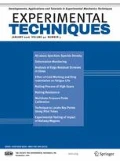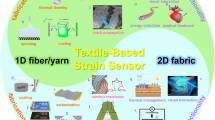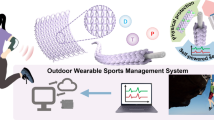Abstract
Paperboard-based composites, typically in the form of carton plies, polyethylene, and aluminum foil, are widely used for food packaging applications. The main goal of packaging converting procedures is to create robust and well-shaped commercial packages. This high speed process is very dynamic, resulting in enormous deformation rates within a few milliseconds. In contrast to previous quasi-static investigations, the envisaged dynamic material characterization for soft and thin paperboard plies will help understand and predict the material response during this high speed packaging process. Even though several experimental standards are already available for paperboard tensile tests, these standards are limited to conventional quasi-static test procedures. Specific cylindrical clamps made of aluminum were designed to prevent samples with a thickness of 100 m from slipping. By means of accurate measuring techniques, a maximum strain rate of 80 s-1 was achieved, which effectively corresponded to actual strain rates that occur in paperboard converting procedures. It was shown that paperboard plies exhibited anisotropic properties and rate-dependent characteristics. Compared to quasi-static properties, the dynamic experiments revealed stiffer hardening properties at higher strain rates. A rate-dependent material model based on Cowper-Symonds and Johnson-Cook analytical laws was generated to formulate a paperboard dynamic constitutive model. Experimental investigations towards analytical material formulations were successfully conducted to predict and determine the rate dependent material characteristics of paperboards plies at high strain rates.












Similar content being viewed by others
Data Availability
• The raw/processed data required to reproduce these findings cannot be shared at this time due to legal and ethical reasons.
• Furthermore, the raw/processed data required to reproduce these findings cannot be shared at this time as the data also forms part of an ongoing study.
Change history
10 November 2021
A Correction to this paper has been published: https://doi.org/10.1007/s40799-021-00526-5
References
Stenberg N, Fellers C (2002) The out-of-plane Poisson’s ratios of paper and paperboard. Nord Pulp Pap Res J 17(4):387–394. https://doi.org/10.3183/npprj-2002-17-04-p387-394
Li Y, Stapleton SE, Reese S, Simon JW (2016) Anisotropic elastic-plastic deformation of paper: in-plane model. Int J Solids Struct 100–101:286–296. https://doi.org/10.1016/j.ijsolstr.2016.08.024
Nygårds M, Just M, Tryding J (2009) Experimental and numerical studies of creasing of paperboard. Int J Solids Struct 46(11–12):2493–2505. https://doi.org/10.1016/j.ijsolstr.2009.02.014
Kirwan MJ (2013) Handbook of paper and paperboard packaging technology. Wiley, Hoboken. https://doi.org/10.1002/9781118470930.ch13
Xia QXS, Boyce MC, Parks DM (2002) A constitutive model for the anisotropic elastic-plastic deformation of paper and paperboard. Int J Solids Struct 39(15):4053–4071. https://doi.org/10.1016/s0020-7683(02)00238-x
Borgqvist E, Wallin M, Ristinmaa M, Tryding J (2015) An anisotropic in-plane and out-of-plane elasto-plastic continuum model for paperboard. Compos Struct 126:184–195. https://doi.org/10.1016/j.compstruct.2015.02.067
Tjahjanto DD, Girlanda O, Östlund S (2015) Anisotropic viscoelastic-viscoplastic continuum model for high-density cellulose-based materials. J Mech Phys Solids 84:1–20. https://doi.org/10.1016/j.jmps.2015.07.002
Beex LAA, Peerlings RHJ (2009) An experimental and computational study of laminated paperboard creasing and folding. Int J Solids Struct 46(24):4192–4207. https://doi.org/10.1016/j.ijsolstr.2009.08.012
Li Y, Stapleton S, Simon JW, Reese S (2016) Experimental and Numerical Study of Paperboard Interface Properties. Exp Mech 56(8):1477–1488. https://doi.org/10.1007/s11340-016-0184-8
Nygårds M, Fellers C, Östlund S (2007) Measuring out-of-plane shear properties of paperboard. J Pulp Pap Sci 33(2):105–109
Huang H, Hagman A, Nygårds M (2014) Quasi static analysis of creasing and folding for three paperboards. Mech Mater 69:11–34. https://doi.org/10.1016/j.mechmat.2013.09.016
Allaoui S, Aboura Z, Benzeggagh M (2009) Phenomena governing uni-axial tensile behaviour of paperboard and corrugated cardboard. Compos Struct 87(1):80–92. https://doi.org/10.1016/j.compstruct.2008.01.001
Henry W, Haslach JR (2000) The moisture and rate-dependent mechanical properties of paper. Mech Time-Depend Mater 4:169–210. https://doi.org/10.1023/A:1009833415827
Godshall W (1965) Dynamic tension testing equipment for paperboard and corrugated fiberboard. In: U. S. Forest Service research note no. 081, U. S. Department of Agriculture, Forest Products Laboratory, Madison, WI, USA
Paca FB (1960) The response of materials to dynamic loads. U.S. Army ERDL Report 1643-TR
Tiemann HD (1908) The effect of the speed of testing upon the strength of wood and the standardization of tests for speed. Proc Am Soc 8:541
Xiao X (2008) Dynamic tensile testing of plastic materials. Polym Test 27.2:164–178. https://doi.org/10.1016/j.polymertesting.2007.09.010
Liu W (2015) Identification of strainrate dependent hardening sensitivity of metallic sheets under in-plane biaxial loading. PhD thesis, Institut National des Sciences Appliquées de Rennes, Rennes, France
Ou Y, Zhu D, Zhang H, Yao Y, Mobasher B, Huang L (2016) Mechanical properties and failure characteristics of CFRP under intermediate strain rates and varying temperatures. Compos Part B: Eng 95:123–136. https://doi.org/10.1016/j.compositesb.2016.03.085
Cherif C, Seidel A, Younes A, Hausding J (2010) Evaluation of a tensile test for the determination of the material behaviour of filament yarns under high strain rates. Autex Res J 10.4:88–94
Younes A, Sankaran V, Seidel A, Waldmann M, Cherif C, Hausding J (2012) Stress-strain behavior of carbon filament yarns under high strain rates. Text Res J 82.7:685–699. https://doi.org/10.1177/0040517511433151
Gavrus A (2012) Constitutive equation for description of metallic materials behavior during static and dynamic loadings taking into account important gradients of plastic deformation. Key Eng Mater 504:697–702. https://doi.org/10.4028/www.scientific.net/kem.504-506.697
Gambirasio L, Rizzi E (2016) An enhanced Johnson–Cook strength model for splitting strain rate and temperature effects on lower yield stress and plastic flow. Comput Mater Sci 113:231–265. https://doi.org/10.1016/j.commatsci.2015.11.034
Gyliene V, Ostasevicius V (2011) Cowper-Symonds material deformation law application in material cutting process using LS-DYNA FE code: turning and milling. In: LS-DYNA® 8th European Users conference
Acknowledgements
The first author gratefully appreciates the technical support from TUDATEX GmbH (Dresden, Germany) and financial support of SIG Combibloc System GmbH during his PhD work. Moreover, the authors acknowledge the Institute of Applied Mechanics (IFAM) of RWTH Aachen University and German Institutes of Textile and Fiber Research (DITF) Denkendorf, Germany for their technical support for the material test experiments.
Funding
This study was funded by Company SIG Combibloc System GmbH.
Author information
Authors and Affiliations
Corresponding author
Ethics declarations
Conflict of Interest
First Author has received research grants from Company SIG Combibloc System GmbH.
Additional information
Publisher’s Note
Springer Nature remains neutral with regard to jurisdictional claims in published maps and institutional affiliations.
This article was updated to correct the spelling of Abolhasan Nazarinezhad Giashi in the author list.
Rights and permissions
About this article
Cite this article
Nazarinezhad Giashi, A., Gereke, T., Mbarek, T. et al. Novel Dynamic Test Methods for Paperboard Composite Structures. Exp Tech 46, 849–860 (2022). https://doi.org/10.1007/s40799-021-00496-8
Received:
Accepted:
Published:
Issue Date:
DOI: https://doi.org/10.1007/s40799-021-00496-8




